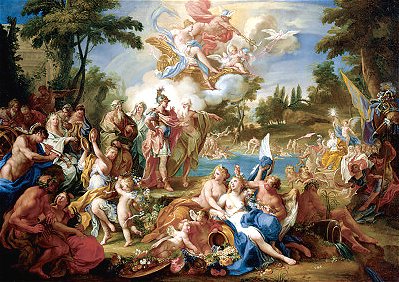VISION OF AENEAS IN THE ELYSIAN FIELDS
SN 168, oil on canvas, c.1735-40
Sebastiano Conca
Italian, 1680-1764
From "The Pages"
ARTIST:
Conca was born in Gaeta, c1680. He was active chiefly in Rome. By 1725 he was already a
famous painter, celebrated throughout Europe for his altarpieces, frescoes, and easel
paintings. He trained in Naples and spent 45 years in Rome, a pupil of Luca Giordano &
Francesco Solimena. In Rome his inspirations were the art of Michaelangelo, Raphael, and
the Bolognese Caraccis. |
|
 |
He had commissions from cardinals for churches, palaces, and hunting lodges. He
executed frescoes for the Spanish queen Elizabeth in 1725. He had a studio in Rome which
attracted French, German, and Spanish pupils such as Batoni and Mengs. Engravings also
spread his style. He died in Naples in 1764.
SUBJECT:
The scene is busy, thronged with people, and illustrates a mythologic tale.
neas was the son of Aphrodite & a prince of Troy, second only to Hector as a great
warrior. His wanderings after the fall of Troy are the subject of Virgil’s epic poem,
the neid , which concludes with neas landing on the shores of Italy & founding
Rome.
The painting immortalizes a dramatic moment. Led by his father, Anchises, and followed by
the Sybil and the seer Mus us, neas gazes around Greek heaven – a place of bliss
– the Elysian fields. The river Lethe flows through the landscape, which is populated
with dead souls who have been purged of impurities and are ready to be sent back to life
in new bodies (transmigration of souls). Approaching from the right is Roma, in a chariot
drawn by lions. Among her followers are Noma Pompilius, the Roman lawgiver (young man
dressed in a toga) with (on horseback) Augustus and Marcellus: a prophecy of the future
grandeur of Rome.
On the left is the poet Virgil, playing a lyre. He is surrounded by philosophers,
astrologers, shepherds, and maidens who sing his bucolic poems. Pan plays his pipes,
another plays the cymbals, accompanying them. In the foreground is an overturned jar
spilling water from which nature’s abundance will grow (Tiber river symbol).
Floating above neas is his mother, Venus, in a chariot drawn by 2 doves. She is
accompanied by Mercury and Cupid. Souls that were too impure to cleanse are used in brute
animals instead – e.g., lions, tigers, cats, dogs, and monkeys.
PAINTING:
Conca’s paints in the Neopolitan-Roman manner, which mediates between the grandeur of
late Baroque and the new Roman Rococo. Individual and mannered, his style is free and
fluent, with able draftsmanship. The intellectuals’ taste was attracted to the
spontaneous and lyrical, which was influenced by the Society of Arcadia. Conca toned down
the Baroque exuberance, creating a lighter and more balanced composition. His colors in
1730-52 were liquid and transparent, applied with spontaneous brushwork.
The composition is busy and pyramidal, with the individual parts arranged in an arbitrary
system of proportion. There is easy flow throughout the painting.
The work is intimate, small, compact, and as engaging as an operetta; it is both
theatrical, and reactive against empty Baroque rhetoric.
HISTORIC CONTEXT:
Conca’s employment by foreign patrons is second only to Tiepolo’s, but
Conca’s career was probably more lucrative. He had far more individual commissions.
Private collectors as well as travelers collected his easel paintings, so that his work
was dispersed to France, Spain, Portugal, Poland, Germany, and Austria. He wrote a
theoretic work which contained moral and artistic precepts for young men intending
painting careers.
In the 18th c. Rome was the Mecca for artists, who often stayed because of the commissions
available from an international market for Italian-trained painters in the classical mode.
Economically and politically Italy itself was in a decline; the papal government became
retrograde and it was not reborn.
The new Rococo in Rome produced smaller easel paintings that distilled classical subjects
into compact works; they took painting from “grand opera” to
“operetta.”
Tomory mentions SN 168 is close in style and composition to the “Departure of
Rnaldo” signed and dated 1741, thus a popular theme of the 18th c.
Museum Label:
The Vision of Aeneas in the Elysian Fields
c. 1735/1740
Oil on canvas, 48 5/8 x 68 1/2 in. (123.5 x 174 cm)
Artist: Sebastiano Conca
Italian, 1680-1764, active in Naples
This work depicts a passage from Virgil's Aeneid, the epic story of the Trojan warrior
Aeneas whose descendants would found Rome. The helmeted hero descends to Elysium, the part
of the underworld reserved for heroes whose souls will be reborn. Surrounded by future
Roman leaders (including Emperor Augustus on horseback), Anchises, Aeneas' deceased
father, tells his son of the grandeur Rome will enjoy. Venus, Aeneas' mother, and Mercury
hover above in a chariot, while Virgil plays a lyre at the left.
Bequest of John Ringling, 1936, SN168
ringlingdocents.org
|
